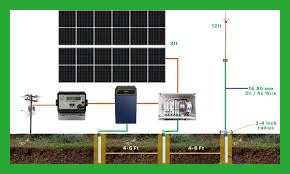solar financing Pakistan
Solar financing in Pakistan is an opportunity to install solar energy products in no time.
I. Introduction
Pakistan is endowed with significant solar energy potential, receiving approximately 2,000-2,500 hours of sunlight annually, which translates to about 5-7 kWh/m²/day. This abundance makes solar energy a key player in addressing the country’s energy crisis, which has historically been characterized by power shortages and reliance on fossil fuels. The transition to solar energy not only promises a sustainable energy source but also supports economic growth, job creation, and environmental benefits.
Financing is a critical component for the successful deployment of solar projects. Many potential investors and developers face challenges due to high initial costs and limited access to capital. Effective solar financing mechanisms can bridge the gap between available technology and its implementation, thus accelerating the adoption of solar energy solutions across the country. This paper will explore the current state of solar energy in Pakistan, available financing options, challenges, and potential solutions, culminating in a future outlook for solar financing in the region.
II. Current State of Solar Energy in Pakistan
The solar energy landscape in Pakistan has evolved significantly over the last decade. The country has seen an increase in solar installations, particularly in off-grid areas, where electricity access is limited. Government initiatives, such as the Alternative Energy Policy, aim to boost renewable energy sources, with solar energy targeted to contribute substantially to the national grid.
Key stakeholders in the solar sector include the government, private investors, non-governmental organizations (NGOs), and international development partners. The government has introduced various incentives, such as net metering policies and tax exemptions on solar equipment, to encourage private investment. However, the pace of adoption is still hampered by bureaucratic inefficiencies, insufficient infrastructure, and a lack of awareness among consumers.
III. Financing Options
A diverse range of financing options is crucial for the growth of solar energy in Pakistan:
A. Government Grants and Subsidies: The government offers various grants and subsidies aimed at reducing the financial burden on solar projects. Programs like the Pakistan Renewable Energy Policy encourage investment by providing fiscal incentives and rebates for solar installations.
B. Bank Loans and Financial Institutions: Commercial banks in Pakistan are gradually recognizing the potential of solar energy and are starting to offer tailored loan products for solar projects. Microfinance institutions also play a vital role in financing smaller solar systems, particularly for low-income households.
C. International Funding and Partnerships: Organizations such as the World Bank and Asian Development Bank (ADB) provide financial assistance for renewable energy projects in Pakistan. These funds often come with favorable terms and are aimed at promoting sustainable energy initiatives.
D. Private Investment: The rise of venture capital and private equity investments in the renewable energy sector reflects growing interest. Crowdfunding platforms also emerge as innovative financing sources, enabling individuals to invest in solar projects directly.
IV. Challenges in Solar Financing
Despite the availability of financing options, several challenges persist:
A. High Upfront Costs: The initial investment required for solar installations can be a significant barrier for many potential adopters, particularly in rural areas.
B. Lack of Awareness and Education: Many consumers and businesses are still unaware of the benefits of solar energy and available financing options. This knowledge gap can deter investments.
C. Regulatory Hurdles: Complex regulations and lengthy approval processes can create uncertainty for investors and slow down project implementation.
D. Creditworthiness of Potential Borrowers: Limited credit history and low financial literacy among potential borrowers can make it difficult for lenders to assess risk accurately.
V. Solutions and Strategies
To overcome these challenges, innovative solutions are required:
A. Innovative Financing Models: Approaches like pay-as-you-go (PAYG) models allow consumers to pay for solar energy over time, making it more affordable and accessible.
B. Public-Private Partnerships: Collaboration between the government and private sector can enhance investment in solar projects, combining public resources with private expertise.
C. Capacity Building and Awareness Campaigns: Educating stakeholders about solar energy benefits and financing options is crucial. Targeted campaigns can help dispel myths and build confidence in solar investments.
VI. Case Studies
Successful solar financing projects provide valuable lessons. For example, the Solar Home Systems project in off-grid regions has demonstrated the effectiveness of microfinancing models, improving energy access for rural communities. Additionally, international partnerships, such as those with the United Nations Development Programme, have successfully funded solar projects that provide electricity to schools and health facilities, showcasing how collaborative efforts can lead to impactful results.
VII. Future Outlook
The future of solar energy financing in Pakistan looks promising, driven by technological advancements, declining costs of solar equipment, and increasing awareness of climate change. As global investment in renewable energy continues to grow, Pakistan can leverage its abundant solar resources to attract both domestic and international investors. Policymakers will play a crucial role in creating a conducive environment for solar financing by streamlining regulations and enhancing incentives.
VIII. Conclusion
Solar financing in Pakistan represents both a challenge and an opportunity. By addressing existing barriers and leveraging innovative solutions, stakeholders can significantly enhance the adoption of solar energy across the country. The potential for sustainable energy not only offers economic benefits but also supports Pakistan’s commitments to environmental sustainability and energy security.
IX. References
To ensure the credibility of this analysis, relevant academic papers, industry reports, and government publications will be compiled, providing a comprehensive resource for further exploration of solar financing in Pakistan.
This detailed structure gives a comprehensive view of solar financing in Pakistan, highlighting critical aspects necessary for understanding the current landscape and future opportunities.

